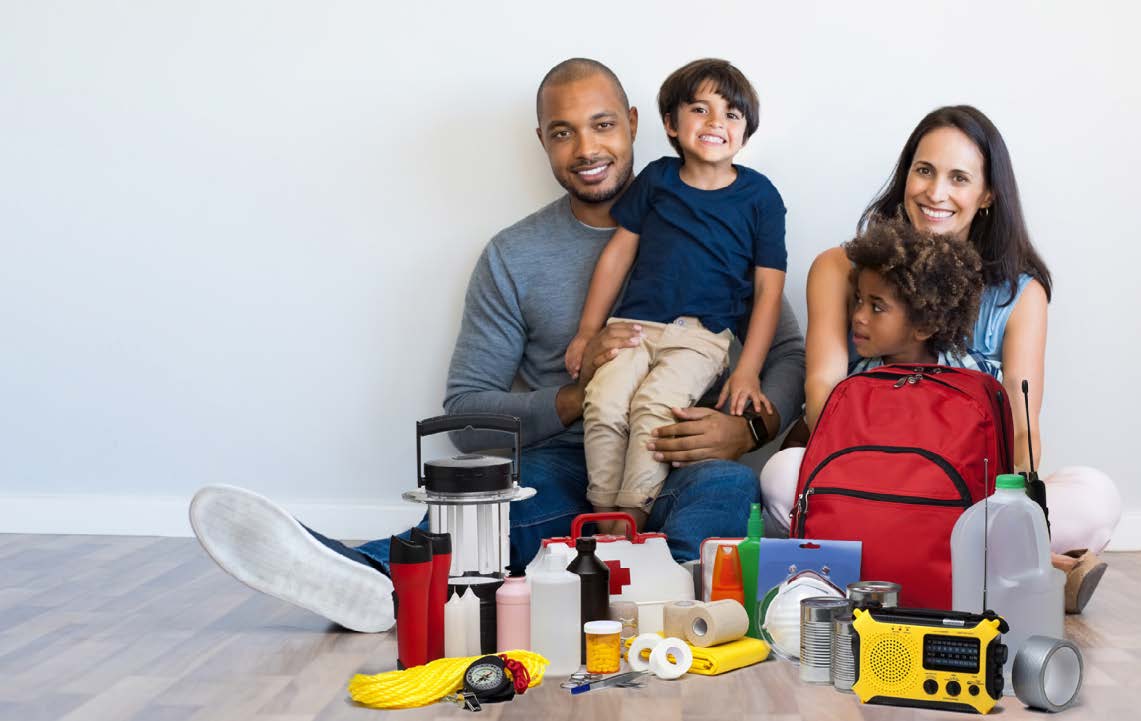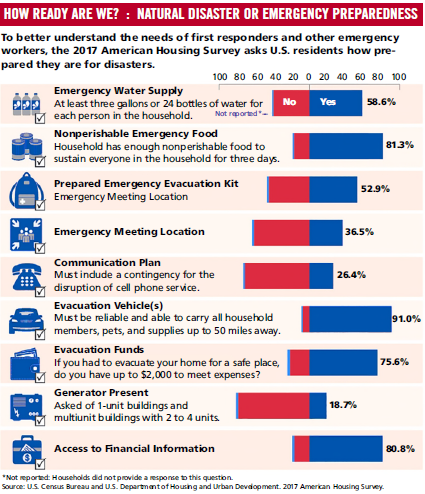
BY LAURA GEORGE
"Mom? Dad? What is emergency preparedness?" Most parents do not hear this question from their children unless they are exposed to a presentation at school and perhaps only if they are curious.
What is more commonly heard after a disaster in the media is, "What happened to my parents?" or, "I wish my child would have known what to do!" This would be followed by a graphic of a parent with their face in their hands. As parents, we need to create the culture of emergency preparedness that we would like our children to practice and observe. Furthermore if it is said that a child with disabilities cannot prepare or be prepared, that person is wrong.
TALK ABOUT IT
First, consider the child's age, their emotional well-being, and their capacity to understand the topic. Do not define the topic for them. Find out what they think it is, when it is used, and why it might be important for them. Talk about the emotions they might feel and how to work around them when disaster strikes. Then take those discussions and have them apply those thoughts as to how it would apply to others around them.
ENCOURAGE OWNERSHIP
Encourage them to take part in the creation of the plan for themselves, their siblings, family pet, other family members, and even their home. Allow them to create their own emergency prepared ness kit. For younger children or those with developmental delays, get a white pillowcase, some fabric markers, and let them create the pictures and wording for their kit. Take them to a dollar store or have them walk around the house, picking items to go inside the pillowcase. Let them add their favorite stuffed animal or toy. If it is electronics, help them to remember to grab backup power or batteries for it.
ENCOURAGE RESPONSIBILITY
Regardless of the disability type, make sure they add the things they think they need to assist them with daily living routines in a 24-hour period. Again, batteries or power supply cords might be needed. Make it fun. Perhaps make up a game to think of the top five medical supplies they need. Make sure they know how to carry their medication. Do not forget their favorite shelf foods and drinks. Ensure that all their food items are easy to open with minimal assistance. See what other items they think would be important to add, such as catheters, treats for their service dog, a small blanket to keep them warm, and other items. If they require access to refrigerated foods and medications, have them share in the creation of a way to maintain the cold temperatures. I bet whatever they come up with will make you smile.
YOUNG CHILDREN
For toddlers and young babies, make sure you have a week's worth of standard supplies such as diapers and formula. Continue further with that list and remember oxygen, tubes or other unique supplies. If the child has serious medical needs, consider asking your police or fire department to visit your home and conduct a wellness visit. This helps them to understand the situation, the child's needs, and what medical equipment or supplies are needed to maintain their ability to live. Follow that through to include others who might care for the child, including other members of the medical community, their friend's parents, coaches and so forth. Remember, the time to make sure your baby has access to oxygen is not after you've survived a flooding disaster.
OLDER CHILDREN
If you have an older child, show them your private documents and how to access them if you are not around. Make sure that there is a shareable password or location where it can be found if some of the household documentation is on the computer. Sit down with them and discuss both serious and non-serious events, teaching them what items will trigger you into taking different actions to be safe and prepared in a disaster. Engage their help in planning for the family's safety. Again, if they have developmental disabilities, present the discussion in a manner that will not panic them, but allow them to feel confident in their thoughts about what to do. Teach your children how to read a paper map. Get them spare house keys and teach them where the electrical box is. Even if they can't reach the box, they should be able to tell a first responder where it is.
UNIQUE CONCERNS
For children with developmental disabilities, or highly serious medical conditions, using everything from simplistic language to placing labels on their items should be considered. Give additional consideration to spare hearing aids or communication equipment, spare visual aids like eyeglasses or canes, medication needles (Epipen or insulin), head phones for sound sensitivity or any other specialized durable medical equipment that might be also needed. A favorite of mine to include is a helmet for tornado safety. If a will exists, consider writing in plans to accommodate their needs for the worst-case scenario, as well as financial coverage and living concerns. Talk about preparedness at different times and locations throughout the year on a regular basis.

PLAY OUT SCENARIOS
Discuss a variety of "what if" disaster scenarios such as fire, tornado, traffic accident or active shooter, the locations that they might occur in and how preparedness and safety might occur. Take the next step beyond that and ask them about things that might occur when with friends, other family or while shopping and what they would do. Ask them what they would do if some thing happened to you while at work and what their next steps would be. Make sure they know who and how to contact another family member or adult they can stay with while your affairs are addressed. If they are younger, make sure they know they know the street address of where they live or at least primary contact phone numbers. Consider scheduling a visit to the local fire department or police department so they can be familiar with first responder uniforms and mannerisms. On the flip side, it allows the first responders to learn more about your child with a disability that might need extra assistance. After the visits, create family drills to reinforce the disaster preparedness skills that might be needed. Try to use realistic sounds and timings for additional emphasis. Have them practice travel paths using a paper map. Having prior knowledge will help keep their fear and anxiety levels down when actually needing to apply the learned information.
TRUE STORIES
In Florida I have a fellow advocate mom friend who has a 17 year old with Downs syndrome and autism who survived Hurricane Michael. They started teaching the teen how prepare for a tornado in their home the prior year. When the teen refused to participate, they created the code, "Danger! Danger!" and continued to practice with that code on a monthly basis. A year later, when Hurricane Michael came, she had her older son keep her teen occupied while she prepared. Then she prepared with the teen and they packed a bunch of their favorite toys. (For comfort this is perfect!) Then she took a chance and used the code words. It worked, and the teen took coverage easily without issue.
At a recent presentation after being questioned if it was actually possible to involve children with disabilities in preparedness, I turned to my daughter without warning and asked a number of questions, to which she gave the following answers: "I know my mom's phone numbers, where I live, some family and friends, in case something happens to my mom, where the important documents are and why I should know about them, as well some of my medical needs that need to be in my preparedness kit. Active Shooter? If it was in a store, I would look for a dark place to hide and observe to see if I can escape, or wait for the police and walk out with my hands up so they know I'm not a bad guy. But mom! We never practiced the last question." Actually, we had, but she still has issues with her memory from PANDAS and we had practiced it before. (Proud mom moment!)
Keeping your family prepared, instead of being highlighted as disaster impacted in the media is important. "Mom? Dad? I hear the tornado sirens going off and have my toy bear. Do I need to go downstairs or in the hallway?" That should be what you calmly hear from your children while you prepare. Remember, engaging your children in the topic of emergency preparedness is a forever loving gift that you will have confidently instilled in them, guaranteeing their ability to survive a disaster for many years to come. •
[Author's note: A big thank you goes to the women of the Telic Empowerment meeting this past September ( TelicEmpowerment.org) for being the inspiration for this article. Immediately after presenting to them on National Preparedness Month, they expressed their deep concern as caregivers that there was no education out there speaking directly to them on how to do emergency preparedness for their children with disabilities. One parent in particular felt overwhelmed by the topic due to the fact that she had three children with developmental delays. This is for them and all other parents of children with disabilities!]
ABOUT THE AUTHOR: Laura George is an Emergency Management Disability Liaison and sits on the National Center for Independent Living Emergency Preparedness Committee [ NCIL.org] as well as other national, state, and local committees. She has assisted with flood, hurricane and tornado disasters spanning from Colorado to Texas to North Carolina and the Bahamas. Overall, she has spent the last 13 years volunteering her time, consulting, presenting and writing on the idea that emergency design needs to include everyone. She is the author of Emergency Preparedness Plan: A Workbook for Caregivers, People with Disabilities, the Elderly and Others. In her spare time, she shares smiles with her daughter and dog (assistant), Turkey.
KEEPING KIDS SAFE : PREPAREDNESS COMMUNICATION ASSISTING TOOLS
SEW GOOD BY DOLORES! Customizable seatbelt cover with a pocket to add additional information. faisonanne.com/must-have-medical-seat-belt- strap-cover
IF I NEED HELP Wearable ID Tags (Digital QR codes) that can be placed on clothing, bags, and more. ifineedhelp.org/shop/iD%20Items/12
SMARTSOLE GPS tracker placed inside the shoes gpssmartsole.com/gpssmartsole
LAUREN'S HOPE Medic Alert Jewelry laurenshope.org
CHILDREN LEADING THE WAY : FUN STUFF FOR KIDS
READY KIDS Parents, teens and kids can come and learn about emergency preparedness through education, fun and participatory groups. One section called, Prepare with Pedro has a downloadable activity book. ready.gov/kids
EMERGENCY PREPAREDNESS FOR CHILDREN WITH AUTISM What to include in your plan, along with making a 72-hour kit for the child with Autism. preparednessmama.com/emergency-preparedness- children-with-autism
DISASTER SAFETY FOR CHILDREN From the American Red Cross with "Monster Guard" app to practice preparedness. redcross.org/get-help/how-to-prepare-for-emergen- cies/disaster-safety-for-children.html
CHILDREN AND YOUTH WITH SPECIAL HEALTHCARE NEEDS IN EMERGENCIES A wide variety of information on preparedness for children with a wide variety of disabilities form the CDC. cdc.gov/childrenindisasters/children-with-special- healthcare-needs.html
THE ULTIMATE FIRE SAFETY GUIDE FOR YOUNG FAMILIES DISASTER SAFETY FOR CHILDREN From the American Red Cross with "Monster Guard" app to practice preparedness. redcross.org/get-help/how-to-prepare-for-emergen- cies/disaster-safety-for-children.html